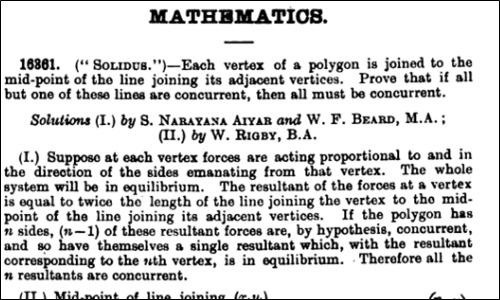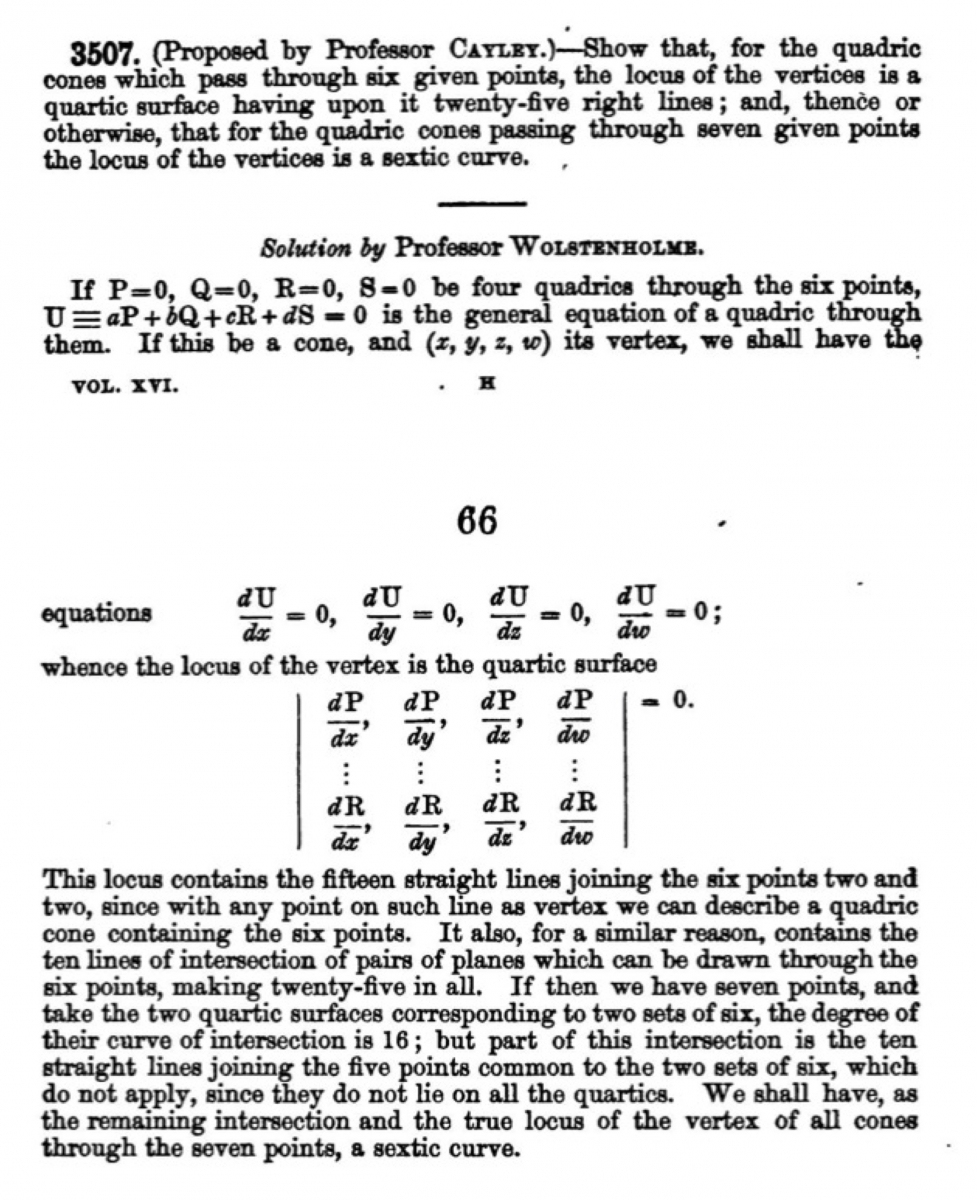- About MAA
- Membership
- MAA Publications
- Periodicals
- Blogs
- MAA Book Series
- MAA Press (an imprint of the AMS)
- MAA Notes
- MAA Reviews
- Mathematical Communication
- Information for Libraries
- Author Resources
- Advertise with MAA
- Meetings
- Competitions
- Programs
- Communities
- MAA Sections
- SIGMAA
- MAA Connect
- Students
- MAA Awards
- Awards Booklets
- Writing Awards
- Teaching Awards
- Service Awards
- Research Awards
- Lecture Awards
- Putnam Competition Individual and Team Winners
- D. E. Shaw Group AMC 8 Awards & Certificates
- Maryam Mirzakhani AMC 10 A Awards & Certificates
- Two Sigma AMC 10 B Awards & Certificates
- Jane Street AMC 12 A Awards & Certificates
- Akamai AMC 12 B Awards & Certificates
- High School Teachers
- News
You are here
The Educational Times Database: International Contributors
Apart from British mathematicians, a number of continental European and Indian mathematicians contributed to the ET. One of the most prolific French contributors to the ET was Joseph Neuberg (1840–1926) , who submitted 365 questions and ninety-six solutions between 1885 and 1915. Most of his contributions concerned geometry, the topic he taught most frequently. Neuberg had grown up in Luxembourg during the 1840s and later attended the University of Ghent in Belgium, graduating in 1862 [MacTutor]. While teaching at various colleges and universities in Belgium, Neuberg co-founded two French-language mathematics journals, Nouvelle Correspondance Mathématique (pub. 1874–1880) and Mathesis (pub. 1881–1915, 1922–1965). The ET’s distinguished reputation in the European mathematical community is evidenced by Neuberg’s decades-long correspondence with the British journal. A less frequent French contributor to the ET was Charles Hermite (1822–1901), whose work concerned algebra and number theory. Hermite worked with invariant theory in the 1850s, at the same time that the theory was being developed by Arthur Cayley and J. J. Sylvester. In related work on elliptic functions, Hermite famously showed that “although an algebraic equation of the fifth degree cannot be solved in radicals,” it “could be solved using elliptic functions” [MacTutor]. Between 1866 and 1896, Hermite contributed twenty-eight problems and six solutions to the ET, mainly on number theory and integral calculus.
Half a world away, one important Indian mathematician who submitted often to the ET was S. Narayana Aiyar (1874–1937). Employed as an accountant at the Madras Port Trust Office in India (from 1900 to 1934), Narayana Aiyar was interested in more than practical accountancy. At the Trust Office he worked with, befriended, and tutored Srinivasa Ramanujan (1887–1920), and in 1914 he “strongly advised Ramanujan to accept [G .H.] Hardy’s invitation to come to Cambridge” [Berndt 2011, 770]. Also, Narayana Aiyar was an early member of the Indian Mathematical Society, which served as a link between the professional mathematical communities in England and India. Several prominent Indian mathematicians contributed both to the Journal of the Indian Mathematical Society and the ET, including M. T. Naraniengar (1871–1940) , S. Narayanan, K. J. Sanjana, R. Ramachandra Rao (1871–1936), and V. Ramaswami Aiyar (1871–1936) [Berndt 2011, 771].

Figure 8. A solution co-authored by S. Narayana Aiyar, in response to an anonymously posed polygon problem.
Narayana Aiyar was a prominent Indian mathematician of the early twentieth century.
Excerpted from Educational Times, April 1908, page 187.
The place of the ET in nineteenth- and early twentieth-century mathematical communities, both in Britain and abroad, can be appreciated not only in terms of the individuals who contributed to it but also in terms of contemporaneous publications. Some of the most puzzling mathematical problems of their day circulated beyond a single institution or publication. These problems might be unsolved, impartially solved, or open to alternate solutions. It is possible to trace some of the journals which reprinted the same or similar problems as those featured in the ET, and thereby identify a few peer publications. For example, in 1900 Benjamin F. Finkel, editor of the American Mathematical Monthly (AMM), noted that a particular geometric problem had been adequately solved in the ET after remaining unsolved in several other publications. The problem was: “If the two bisectors, trisectors, quadrasectors, etc., of a triangle are mutually equal, show that the triangle is isosceles” [Finkel 1900, 227–228]. Some form of this problem had appeared in the Nouvelles Annales de Mathématiques in 1842, The Lady's and Gentleman's Diary in 1856, and The London, Edinburqh, and Dublin Philosophical Magazine in 1874. Another puzzling problem that circulated for many decades concerned the “problem of determining the curve of pursuit in the case of the circle” or, in mathematical terms, integrating the “differential equation of the curve of pursuit for a circle” [Archibald and Manning 1921, 92]. The problem appeared in The Mathematical Monthly (AMM) in 1859, Nouvelle Correspondance Mathématique in May 1877, Mathesis in December 1883, the ET in February 1888, Revue de Mathématiques Spéciales in February 1894, and L'Intermédiaire des Mathématiciens in October 1894. The August 1894 issue of AMM declared the problem unsolvable, but it continued to be discussed in the AMM and Nouvelles Annales for decades thereafter. Finally, mathematician A. S. Hathaway offered a detailed solution in the AMM of February 1921. The publication history of these two example problems demonstrates the ET’s participation in a robust ecosystem of mathematical journals that encompassed England, Scotland, Ireland, India, the United States, and France.

Figure 9. A selected problem and solution from Mathematical Questions, volume 16, 1871, pages 65–66.
The problem was proposed by Arthur Cayley. It was solved by Joseph Wolstenholme (1829–1891), a Cambridge graduate and professor at the Royal Indian Engineering College, a civil service training school located
near London at Cooper’s Hill, now the site of a retirement village.
The influence of the ET in the United States is evident in the biographies of two of the journal’s most famous American readers, Benjamin F. Finkel (1865–1947) and the expatriate Charlotte A. Scott (1858–1931). Finkel’s career is well-known to historians of mathematics. In 1894, while employed as a professor of mathematics at Drury College in Kidder, Missouri, he co-founded the AMM with his colleague John M. Colaw (1860–1931) [Finkel 1931, 308]. By this time, Finkel was already a subscriber to the ET. The AMM was later adopted, in 1915, as the official publication of the Mathematical Association of America (MAA), of which Finkel was a leading member [Parshall 2016, 194]. Finkel’s subscription to the ET, along with his prominent roles as an AMM founder and MAA member, indicate the British journal’s influence across the Atlantic. English mathematician Charlotte A. Scott, a teacher at Girton College until 1885, afterward accepted a position at Bryn Mawr College, Pennsylvania, where she taught for almost four decades [Tattersall and McMurran 2004, 110]. She had achieved her wrangler rank on the Cambridge Tripos exam and established her early reputation, in part, because she had studied with and contributed to the ET. In the United States, her achievements included supervising seven doctoral students, serving as a founder and a chief examiner of the College Entrance Examination Board, co-editing The American Journal of Mathematics with Frank Morley (1860–1937), another notable ET contributor, and being elected as a council member and vice president of the American Mathematical Society. Finkel’s and Scott’s biographies highlight the ET’s connection to the evolution of a professional American—and transnational Anglo-American—mathematical community in the late nineteenth and early twentieth centuries.
Robert M. Manzo (University of North Carolina at Chapel Hill), "The Educational Times Database: International Contributors," Convergence (March 2021)




